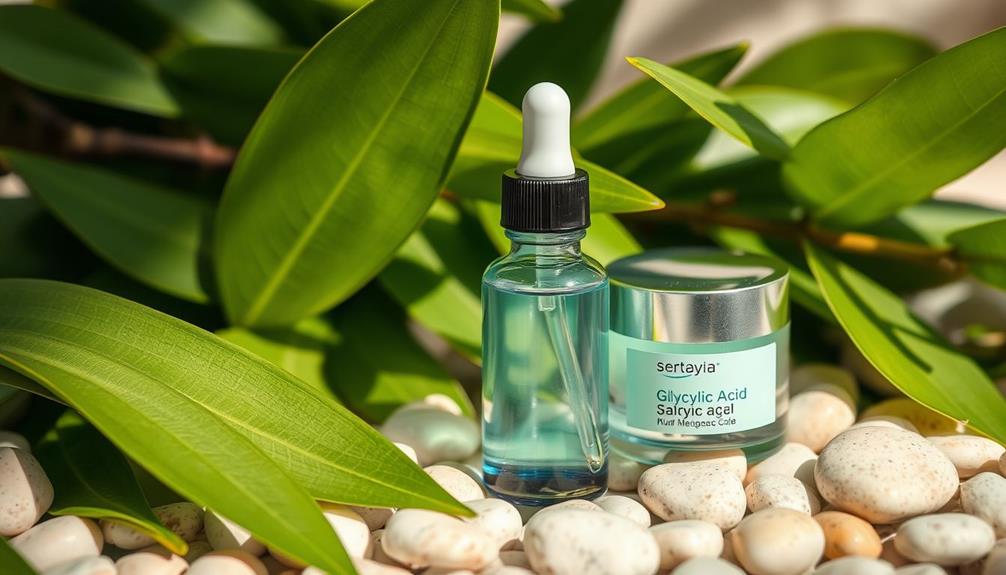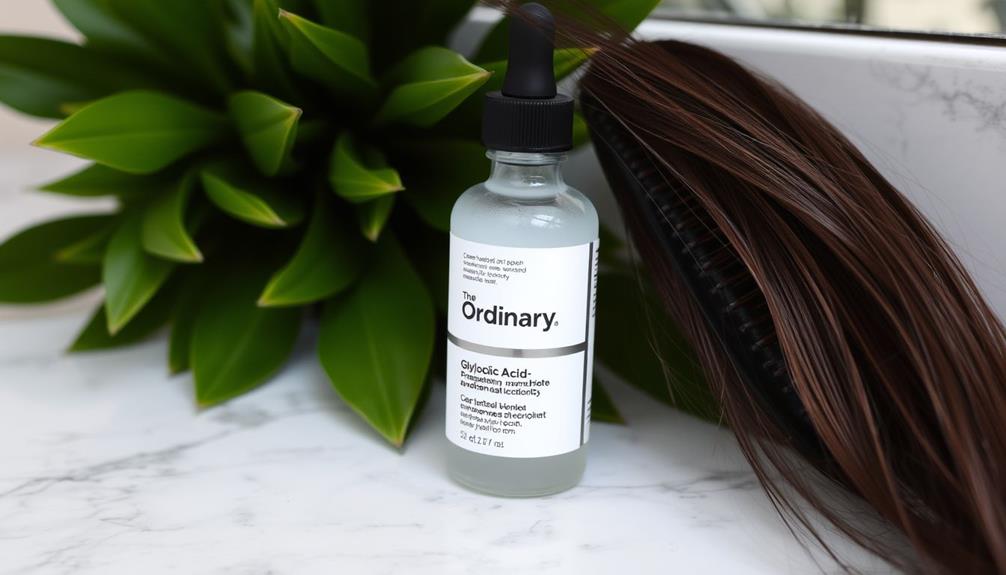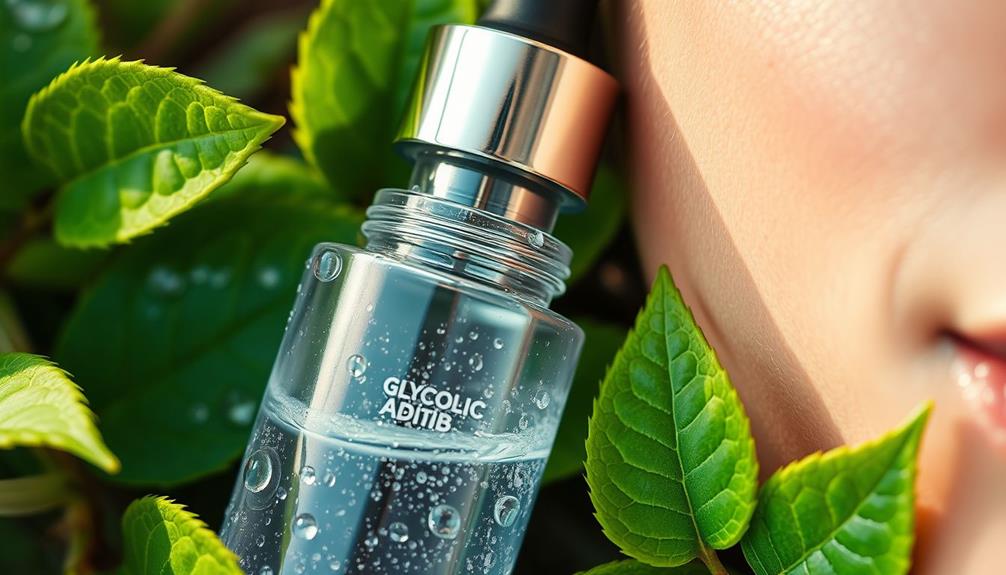Glycolic acid is a potent exfoliant derived from sugar cane that effectively removes dead skin cells by breaking the bonds between them. This action enhances cell turnover, unveiling a fresh, smooth skin surface. With regular use, you can expect improved skin texture, diminished fine lines, and reduced clogged pores, making it a great option for those with acne-prone skin. Additionally, glycolic acid aids in fading dark spots and evening out skin tone by stimulating collagen production. While it may cause some sensitivity, starting with lower concentrations and performing a patch test can help minimize any adverse reactions. If you want to discover more about its benefits and how to include it in your skincare routine, continue your exploration!
Key Takeaways
- Glycolic acid, an alpha hydroxy acid, promotes exfoliation and cell turnover, improving overall skin texture and radiance.
- It effectively unclogs pores, making it beneficial for oily and acne-prone skin while reducing post-acne marks.
- Regular use stimulates collagen production, reducing fine lines and wrinkles, and enhancing skin elasticity.
- Glycolic acid fades dark spots and evens out skin tone through increased cell turnover and hydration.
What Is Glycolic Acid?

Glycolic acid, an alpha hydroxy acid derived from sugar cane, is renowned for its powerful exfoliating abilities that penetrate the skin effectively. Its small molecular size allows it to reach deeper layers, making it an outstanding choice for improving skin texture.
By loosening the bonds between dead skin cells, glycolic acid promotes cell turnover, revealing a fresher, more radiant complexion. Additionally, incorporating natural alternatives like essential oils for skin health can further enhance your skincare routine by providing nourishing benefits.
Regular use of glycolic acid can greatly improve your skin. It's particularly beneficial for oily and acne-prone skin, as it helps unclog pores and prevent breakouts. This exfoliating powerhouse not only addresses blemishes but also enhances overall skin hydration, leaving your skin feeling supple.
Additionally, glycolic acid plays an essential role in fading hyperpigmentation and dark spots, helping you achieve an even skin tone. With consistent application, you'll notice a reduction in the appearance of fine lines and wrinkles, making your skin look youthful and vibrant.
Incorporating glycolic acid into your skincare routine could be the key to transforming your complexion and achieving the healthy, glowing skin you desire.
Mechanism of Action
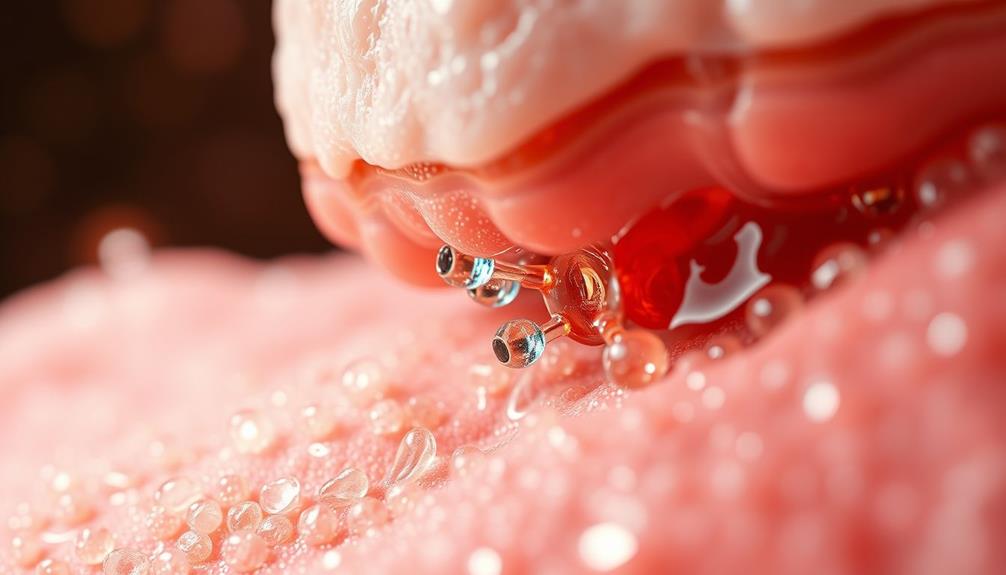
Glycolic acid works wonders for your skin by loosening the bonds between dead skin cells, making exfoliation easier.
Its ability to enhance skin texture is comparable to the benefits of essential oils for skin health, particularly those like Tea Tree and Chamomile known for their soothing properties.
You'll appreciate how its pH balance plays a vital role in maximizing skin tolerance while reducing irritation.
Together, these factors contribute to smoother, healthier skin as you embrace regular use.
Exfoliation Process Explained
The exfoliation process involves glycolic acid loosening the bonds between dead skin cells, making it easier for them to be sloughed away. This effective alpha hydroxy acid (AHA) accelerates cell turnover, allowing fresh, healthier-looking skin to emerge. By promoting the shedding of old skin cells, glycolic acid also helps unclog pores, reducing acne and improving skin texture.
Here's a quick overview of how glycolic acid works:
| Effect | Description |
|---|---|
| Exfoliation | Loosens dead skin cells for easier removal |
| Cell Turnover | Speeds up the shedding of old cells |
| Collagen Production | Stimulates collagen for improved elasticity |
Regular use of glycolic acid leads to enhanced skin elasticity and reduced appearance of fine lines and wrinkles. As you incorporate it into your skincare routine, you'll notice a significant improvement in your skin's overall appearance. Say goodbye to dullness and hello to a brighter, smoother complexion, all thanks to the powerful exfoliation process of glycolic acid!
Ph Balance Importance
Maintaining the right pH balance in skincare products is essential for guaranteeing glycolic acid works effectively and minimizes irritation. The ideal pH for glycolic acid products is around 4, closely matching your skin's natural pH. This balance promotes efficient exfoliation while enhancing skin tolerance, allowing you to reap the benefits without discomfort.
Additionally, similar to the principles of self-exploration through body awareness, understanding how your skin responds to different products can greatly enhance the effectiveness of your skincare routine.
Glycolic acid dissolves the bonds that hold dead skin cells together, encouraging cell turnover and revealing healthier skin beneath. When the pH is optimal, glycolic acid not only exfoliates but also stimulates collagen production, crucial for improving skin elasticity and reducing fine lines.
This balanced environment also enhances glycolic acid's ability to act as a humectant, drawing moisture into the skin and improving hydration.
If the pH strays too far from this ideal range, glycolic acid may become less effective, leading to increased sensitivity and irritation. By prioritizing pH balance in your skincare routine, you guarantee glycolic acid can work its magic, promoting smoother, more radiant skin while maintaining comfort and hydration.
Skin Benefits

How can glycolic acid transform your skin? This powerful alpha-hydroxy acid (AHA) offers numerous skin benefits that can enhance your complexion.
First, it helps exfoliate the skin by breaking down the bonds between dead skin cells, resulting in a smoother, more radiant appearance. Regular use can also stimulate collagen production, which is essential for improving skin elasticity and firmness, helping to reduce the appearance of fine lines and wrinkles.
Additionally, maintaining a balanced diet, including the health of vegan products, can further support your skin's overall health.
If you struggle with acne-prone skin, glycolic acid is particularly beneficial. It unclogs pores, reduces the likelihood of breakouts, and aids in fading post-acne hyperpigmentation.
Additionally, it works wonders in fading dark spots and evening out your skin tone by promoting cell turnover and revealing fresher skin beneath the surface.
Another fantastic aspect of glycolic acid is its ability to enhance hydration. As a humectant, it attracts moisture to the skin, promoting a plump, youthful appearance.
Risks and Precautions
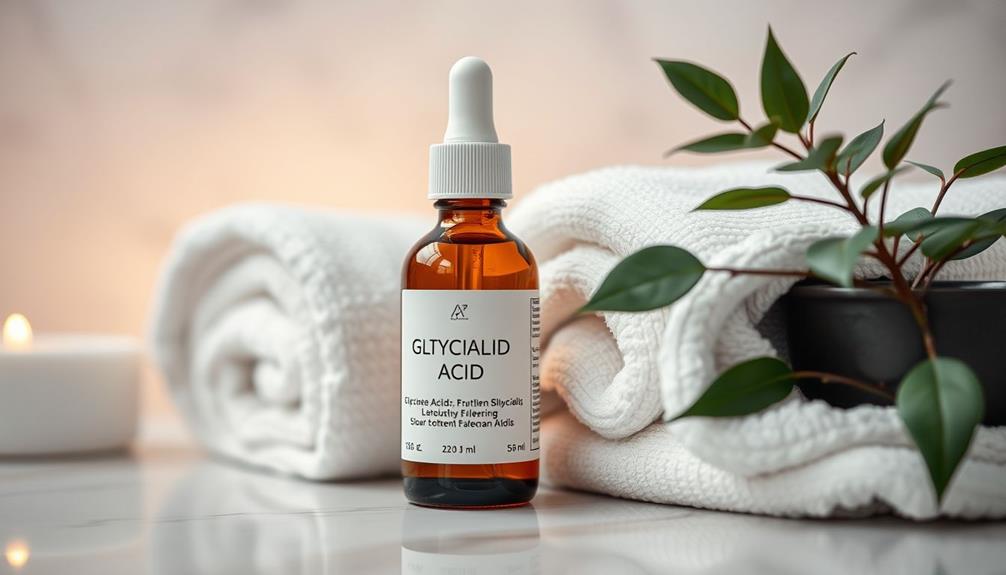
Are you aware that using glycolic acid can come with certain risks and precautions that you should keep in mind? While it can be beneficial for your skin, it's crucial to recognize that glycolic acid may increase skin sensitivity.
Common side effects include redness, itching, swelling, and burning, particularly for those with sensitive skin types. To minimize irritation, you should adhere to recommended concentrations and frequencies when applying glycolic acid. Additionally, incorporating stress management techniques can enhance your overall skin health and help mitigate any potential side effects.
Conducting a patch test before widespread use is highly advisable. This helps you gauge your skin's reaction and can prevent severe irritation or allergic reactions. If you experience significant discomfort, discontinue use immediately.
If you have darker skin types, be especially cautious, as glycolic acid can lead to hyperpigmentation due to irritation. In such cases, seeking professional consultation is a smart move to tailor a safe regimen that suits your skin's needs.
Always remember to wear sunscreen daily, as glycolic acid can heighten your skin's sensitivity to the sun. By following these precautions, you can enjoy the benefits of glycolic acid while minimizing potential risks.
Choosing Glycolic Acid Products

Understanding the risks of glycolic acid sets the stage for making informed choices when selecting the right products for your skincare routine.
Start by looking for glycolic acid products with concentrations between 5% and 10% for at-home use. This range guarantees you get effective exfoliating effects while minimizing irritation.
It's vital to choose products that have a pH around 4, as this aligns with your skin's natural acidity and optimizes the acid's performance.
Additionally, consider exploring yoga for back pain relief to enhance overall wellness, as stress reduction can lead to healthier skin.
Begin your journey with a single glycolic acid product to monitor skin response. This way, you can gauge how your skin reacts before adding more products.
Opt for leave-on formulations, such as serums or moisturizers, as they provide prolonged contact with your skin, enhancing the benefits.
Lastly, always follow up with a broad-spectrum sunscreen during the day. Glycolic acid can increase skin sensitivity to UV rays, making sun protection vital.
Application Guidelines
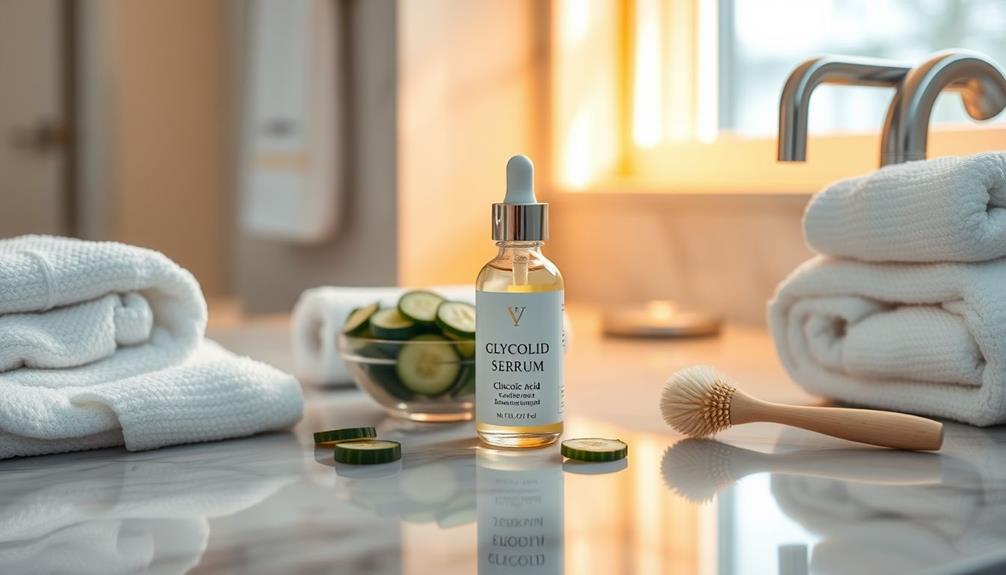
To effectively incorporate glycolic acid into your skincare routine, start with a low concentration of around 5% and gradually increase as your skin adjusts. This allows you to assess your skin tolerance and minimize the risk of irritation.
Begin by applying glycolic acid products in the evening, which helps reduce sun sensitivity. Follow the specific product instructions regarding the amount and frequency of use, but a good starting point is two to three times per week.
Always pay attention to how your skin reacts. If you notice any signs of irritation, consider reducing the frequency of use until your skin acclimates. It's essential to conduct a patch test on a small area of skin before widespread application to avoid severe irritation or allergic reactions.
Additionally, since glycolic acid can heighten your skin's susceptibility to UV damage, always follow up with a broad-spectrum sunscreen during the day. This will help protect your skin and prevent any potential skin damage.
Limitations in Treatment
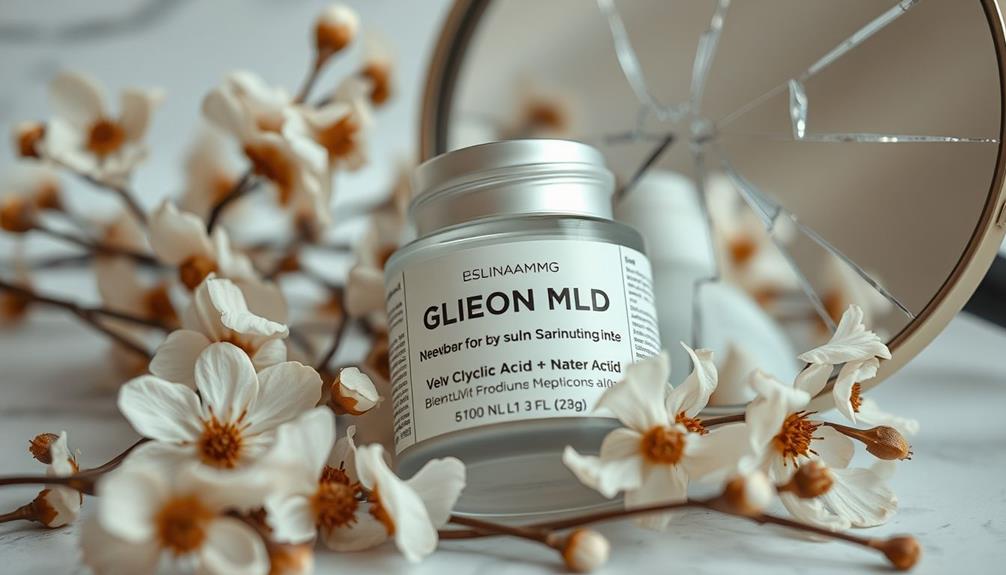
While glycolic acid can enhance skin texture and lighten dark patches, it's important to recognize its limitations in completely removing scars. This powerful exfoliant primarily helps improve the texture of raised and pitted scars, but deeper scars often need more invasive treatments.
You might find that results vary considerably depending on your individual skin types and conditions, which is why personalized treatment plans for scar management are essential.
When considering over-the-counter (OTC) glycolic acid products, keep in mind that they may not deliver the same effectiveness as professional glycolic acid peels. These professional treatments can yield better results, yet even they won't necessarily achieve complete scar removal.
It's also essential to use glycolic acid carefully; overuse can lead to skin irritation, potentially worsening pigmentation issues and hindering the healing process of scars.
Ultimately, while glycolic acid can be a valuable tool in your skincare routine, understanding its limitations will help set realistic expectations. Always consult with a skincare professional to determine the best approach for your specific needs and to explore all available options for scar treatment.
Sources and Availability

Glycolic acid is readily accessible in various forms, making it easy for you to incorporate into your skincare routine. This powerful ingredient, derived from sugar cane, is known for its effectiveness in chemical exfoliation and improving skin texture.
You can easily find glycolic acid in:
- Over-the-counter (OTC) products: Look for cleansers, toners, serums, and masks typically containing concentrations ranging from 5% to 10%.
- Professional glycolic acid peels: Available at salons and dermatology offices, these treatments come in stronger formulations, with concentrations up to 30% and even 70% for more intensive results.
- Skincare brands: Many popular brands incorporate glycolic acid into their formulations, ensuring you have a variety of options to choose from.
- DIY products: While some may consider DIY sugar scrubs, they don't provide the same effectiveness as commercial glycolic acid products due to differing concentrations and formulations.
Frequently Asked Questions
How Long Does It Take for Glycolic Acid to Improve Skin?
It typically takes you about 4 to 6 weeks to notice visible improvements in skin texture and tone. For acne, you might see changes in just 2 to 3 weeks, depending on your skin type.
How to Know if Glycolic Acid Is Working?
You'll know glycolic acid is working when you notice smoother skin texture, reduced fine lines, improved hydration, faded dark spots, and fewer breakouts. These signs indicate it's effectively exfoliating and rejuvenating your skin.
Does Glycolic Acid Repair Skin?
Yes, glycolic acid repairs skin by exfoliating dead cells and promoting cell renewal. It helps fade dark spots, improves texture, and stimulates collagen production, leading to a more youthful and even complexion over time.
What Does Glycolic Acid Do for Skin Daily?
Imagine your skin transforming daily into a radiant canvas! Glycolic acid exfoliates, unclogs pores, boosts hydration, and fights signs of aging, giving you that coveted glow while making your complexion smoother and more youthful with every application.
Conclusion
Incorporating glycolic acid into your skincare routine can lead to impressive results, with studies showing that 90% of users notice improved skin texture and brightness after just a few weeks.
By understanding how it works and following application guidelines, you can maximize its benefits while minimizing risks.
Just remember to choose the right products and listen to your skin.
With consistency, you'll reveal the potential for a more radiant complexion that turns heads!


